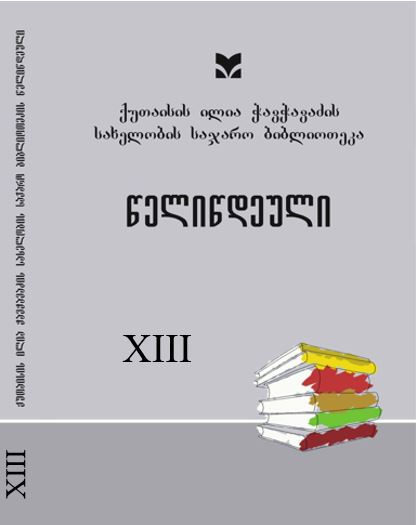Internal Migration from Kakheti - Issues of Political and ethno-cultural history
(On ethnographic materials of surnames migrated to West Georgia)
DOI:
https://doi.org/10.48614/yk.13.2021.149-156Keywords:
Ethnohistory, Anthropotoponyms, The Main Shrines of the genus, The Social Hereditary Names of the GenusAbstract
One part of a proud and difficult way of studying and understanding causes, forms, directions and time of internal migration process of Georgian population is description and complex-ethnohistoric research of the processes of moving from one historical-ethnographic unit to others.
During years, ethnographic materials collected in different time, tell us a history of moving of population of Georgian historical-ethnographic unitKakheti to different communities of Imereti. According to ethnohistoric research of the surnames: Khizaneishvile(<—Gelkhvidze), Chakhunashvili, Gabelashvili, Bakhutashvili, Topadze, Nanikashvili, Arsenidze, Makharoblidze, Makharashvili, Devdariani we learn causes and directions of the migration of the surnames (twice migration); issues of political history and relationship; origin of surnames formed on names created by social status, professional and other signs, eponims [the surname Khizaneishvili is derived from a nickname Khizana; Khizana was an ancestor of the slave of the Chkheidze. They were from Dimi).; Surname Chakhunashvili comes from a person nicknamed ‘Chakhuna’ - a carpenter from Sighnaghi who moved to Gadishi- a village in Vani; Surname Arsenidze derives from a proper noun Arsen. The Arsenidze- ‘Three nests’ live in Sochkheti; The Makharashvili moved from Kaheti are offspring of someone called Makhara]; issues connected with creed, icon [Some people go to Gurna from Kakheti at Tekhisoba to scarify. They associate one of their icons to this place; The area where Gabelashvili lived is called a ‘priest area’]; the cases of adoption; issues of language forms; the cause of migration alongside with many other reasons is considered to be a difficult historical period. It became vivid that the cause of migration was absence of land and water. The history of nobles and social status of slaves are being studied. Historians also study how refugees got surnames from their survivors; the story of ‘relapsing fever’ at different times [It’s true that toponyms of Tsitelkhevi‘sakhazino’(treasury) and ‘sakhadi’ (relapsing fever) is not formed from the surnames of any people, but they are the names of the places where they hide from their enemies and people deceased with relapsing fever.] Interesting materials for researching ethno-cultural history are found in toponyms, second inherited names of the surnames [The Nanikashvili are called ‘Svani’ due to the fact that they are quarrelsome;TheArsenidze in Sochkheti are called ‘Kakhelian’ as they are from Kakheti. The Gelkhvidze in Khani are called ‘Brundebi’ (You are returning). None of the representative of this surname will tell you the truth. They will lead you to the lie) ’Farneebi’ (nickname created according to physical characteristics ‘farna is – a kind of red-white bean, ‘Konkrikhebi’( Kokrikhi is the top of the ridge in Lechkhumi. Compare Konkrikha in Okriba// konkrokhi is said to be a parvenu, an unsuitable person, mostly a woman) ’Fatsureebi’(the part of the people of this surname is fast, hustling people’. Fatsura is a frisky, energetic dog in Guria,’ Mtsvanila’ (Greens) A grandfather made children help him fasten trimmed part of the vine and then fed them with greens); Part of Khizaneishvili is ‘Lekvitchamia’(puppy eaters). Also, there is an example of a cultural mosaic- the surname Laferadze. It’s possible that all elements existing in Georgian languagecultural life aren’t stated.
Hence, unlike Professor Guram Bedoshvili, we consider that these surnames were in Imereti before they were statedin documents and not only issues of Kakheti and Kartli.
Ethnographic materials on the migrated surnames in West Georgia from Kakheti are one of the first sources of ethnohistorical issues. Penetration of natives of different parts of Georgia in the region implemented a consolidation of Georgian ethnic unit and understanding notion of unity.




